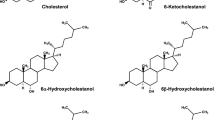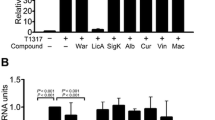Abstract
The farnesoid X receptor (FXR) is a nuclear receptor that regulates gene expression in response to bile acids (BAs). FXR plays an important role in the homeostasis of bile acid, cholesterol, lipoprotein and triglyceride. In this report, we identified fatty acid synthase (FAS) and hepatic lipase (HL) genes as novel target genes of FXR. Human hepatoma HepG2 cells were treated with chenodeoxycholic acid, the natural FXR ligand, and the messenger RNA and protein levels of FAS and HL were determined by RT-PCR and Western blot analysis, respectively. Chenodeoxycholic acid (CDCA) down-regulated the expression of FAS and HL genes in a dose and time-dependent manner in human hepatoma HepG2 cells. In addition, treatment of mice with CDCA significantly decreased the expression of FAS and HL in mouse liver and the activity of HL. These results demonstrated that FAS and HL might be FXR-regulated genes in liver cells. In view of the role of FAS and HL in lipogenesis and plasma lipoprotein metabolism, our results further support the central role of FXR in the homeostasis of fatty acid and lipid.





Similar content being viewed by others
References
Nakamura T, Kugiyama K (2006) Triglycerides and remnant particles as risk factors for coronary artery disease. Curr Atheroscler Rep 8(2):107–110
Ginsberg HN (2001) Hypertriglyceridemia: new insights and new approaches to pharmacologic therapy. Am J Cardiol 87:1174–1180
Jayakumar A, Tai MH, Huang NY et al (1995) Human fatty acid synthase properties and molecular cloning. Proc Natl Acad Sci USA 1292(19):86–95
Oskouian B (2000) Overexpression of fatty acid synthase in SKBR3 breast cancer cell line is mediated via a transcriptional mechanism. Cancer Lett 149:43–51
Wolf SS, Hofer G, Beck KF, Roder K, Schweizer M (1994) Insulin-responsive regions of the rat fatty acid synthase gene promoter. Biochem Biophys Res Commun 203:943–950
Ishii S, Iizuka K, Miller BC, Uyeda K (2004) Carbohydrate response element binding protein directly promotes lipogenic enzyme gene transcription. Proc Natl Acad Sci USA 101:15597–15602
Xiong S, Chirala SS, Hsu MH, Wakil SJ (1998) Identification of thyroid hormone response elements in the human fatty acid synthase promoter. Proc Natl Acad Sci USA 95:12260–12265
Bennett MK, Lopez JM, Sanchez HB, Osborne TF (1995) Sterol regulation of fatty acid synthase promoter. J Biol Chem 270:25578–25583
Kast HR, Nguyen CM, Signal CJ et al (2001) Farnesoid X-activated receptor induces apolipoprotein C-II transcription: a molecular mechanism linking plasma triglyceride levels to bile acids. Mol Endocrinol 15(10):1720–1728
Anisfeld AM, Kast-Woelbem HR, Meyer ME et al (2003) Syndecan-1 expression is regulated in an isoform-specific manner by the farnesoid-X receptor. J Biol Chem 278(22):20420–20428
Bilz S, Samuel V, Morino K et al (2006) Activation of the farnesoid X receptor improves lipid metabolism in combined hyperlipidemic hamsters. Am J Physiol Endocrinol Metab 290(4):716–722
Guo GL, Silvia Santamarina-Fojo, Akiyama TE et al (2006) Effects of FXR in foam-cell formation and atherosclerosis development. Biochim Biophys Acta 1761:1401–1409
Sirvent A, Claudel T, Martin G et al (2004) The farnesoid X receptor induces very low density lipoprotein receptor gene expression. FEBS Lett 566:173–177
Shibata S, Hayakawa K, Eqashira Y et al (2007) Roles of nuclear receptors in the up-regulation of hepatic cholesterol 7alpha-hydroxylase by cholestyramine in rats. Life Sci 80(6):546–553
Ni HX, Yu NJ, Yang XH (2009) The study of ginsenoside on PPARgamma expression of mononuclear macrophage in type 2 diabetes. Mol Biol Rep. Oct 10 [Epub ahead of print]
John Y, Chiang L (2004) Regulation of bile acid synthesis: pathways, nuclear receptors, and mechanisms. J Hepatol 40:539–551
Naoya Y, Hitoshi S, Kiyoshi H et al (2005) Coordinate activation of lipogenic enzymes in hepatocellular carcinoma. Kenichi Eur J Cancer 41:1316–1322
Sirvent A, Verhoeven AM, Jansen H et al (2004) Farnesoid X receptor represses hepatic lipase gene expression. J Lipid Res 459(2):2110–2115
Zeng WW, Zhou B, Liu HR, Sun GT, Chen BS (2009) Identification of the tree shrew ATP-binding cassette transporter A1 (ABCA1) and its expression in tissues: cDNA sequence and expression of tree shrew ABCA1. Mol Biol Rep 36(3):443–448
Zhao YP, Zhang CM, Zhu C, Chen XH, Wang JL, Ji CB, Chi X, Hong Q, Peng YZ, Guo XR (2009) NYGGF4 homologous gene expression in 3T3-L1 adipocytes: regulation by FFA and adipokines. Mol Biol Rep. Nov 6 [Epub ahead of print]
Dugi KA, Amar JM, Haudenschild CC et al (2000) In Vivo evidence for both lipolytic and nonlipolytic function of hepatic lipase in the metabolism of HDL. Arterioscler Thromb Vasc Biol 20(3):793–800
Matsukuma KE, Bennett MK, Huang J et al (2006) Coordinated control of bile acids and lipogenesis through FXR dependent regulation of fatty acid synthase. J Lipid Res 47(12):2754–2773
Angelin B, Einarsson K, Hellstrom K, Leijd B (1978) Effects of cholestyramine and chenodeoxycholic acid on the metabolism of endogenous triglyceride in hyperlipoproteinemia. J Lipid Res 19:1017–1024
Bateson MC, Maclean D, Evans JR, Bouchier IA (1978) Chenodeoxycholic acid therapy for hypertriglyceridaemia in men. Br J Clin Pharmacol 5:249–254
Watanabe M, Houten SM, Wang L, Moschetta A, Mangelsdorf DJ, Heyman RA, Moore DD, Auwerx J (2004) Bile acids lower triglyceride levels via a pathway involving FXR, SHP, and SREBP-1c. J Clin Invest 113:1408–1418
Dichek H, Johnson S, Akeefe H et al (2001) Hepatic lipase over expression lowers remnant and LDL receptor-deficient mice. J Lipid Res 42(2):201–210
Acknowledgements
The work was supported by a research grant from the Chongqing natural science foundation of China (No. CSTC, 2007BB5050) and Research Foundation of Third Military Medical University (No. 06HG010).
Author information
Authors and Affiliations
Corresponding authors
Additional information
Li-Li Shen and Hong Liu have contributed equally to this work.
Rights and permissions
About this article
Cite this article
Shen, LL., Liu, H., peng, J. et al. Effects of farnesoid X receptor on the expression of the fatty acid synthetase and hepatic lipase. Mol Biol Rep 38, 553–559 (2011). https://doi.org/10.1007/s11033-010-0140-0
Received:
Accepted:
Published:
Issue Date:
DOI: https://doi.org/10.1007/s11033-010-0140-0




